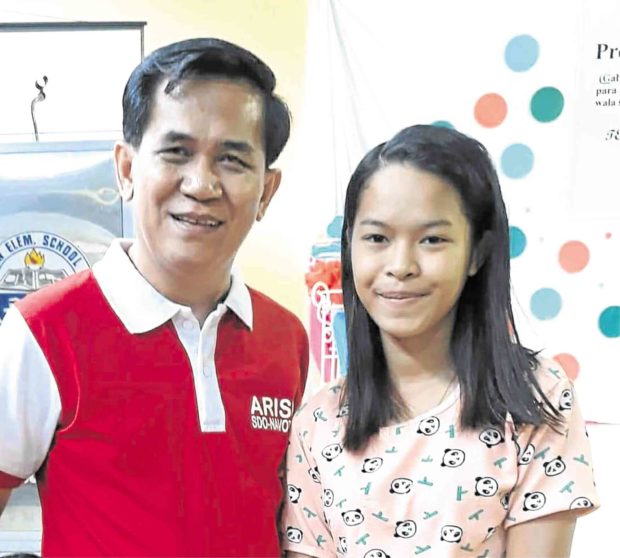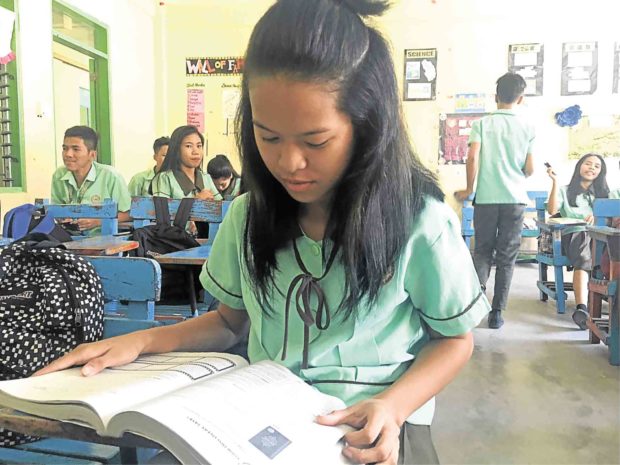From diamond in the rough to ‘Gem’
At 16, Francesca Nicole Lumalang of Navotas City has spent more time in the school of hard knocks rather than a traditional classroom.
Born to a poor couple with three other siblings, she dropped out of second grade to help her mother run the household after her stepfather died.
Money was always tight, she recalled, which meant that attending school was not a priority. “It was hard. I was stuck for a long time,” Nicole recalled. “I was scared there was never going to be a point where I could catch up.”
Even so, the girl sought out alternative classrooms in the community where she grew up. She read her cousins’ books and attended volunteer-led classes around the city. Raring to go back to school at age 14, she took the Department of Education’s Philippine Educational Placement Test (PEPT) which rated her abilities as equivalent to that of an eighth grader.
Now a Grade 9 student at Kaunlaran High School in Barangay Kaunlaran, Nicole is enrolled under Navotas City’s one-of-a-kind alternative learning system (ALS) program where “foster parents” oversee her schooling. She is now among the city’s “gems,” mined among diamonds in the rough, to give them a chance to shine.
Article continues after this advertisement
Thanks to her “foster parents,” Kaunlaran High School principal Cristina Castillo Miclat (left) and Cristelita de la Cruz, Nicole (center) has a chance to realize her dream of becoming a teacher.—KRIXIA SUBINGSUBING
Partnership for a good cause
Article continues after this advertisementDubbed Project Gabay Edukasyon ng mga Kabataang Wala sa Paaralan (Gem), the program targets out-of-school youth (OSY) and students at risk of dropping out. They are “adopted” by volunteers or foster parents who will guide them through their studies until they complete their basic education.
Students aged 10 to 21 are eligible for the program, said project cosupervisor Luisa Elipan. The foster parents, often faculty members and community volunteers, can adopt their gem from the city’s public schools or other ALS programs.
But caring for a gem isn’t just about helping them complete their coursework but also providing the emotional support they need to stay on track, Elipan said. Beyond assignments and projects, the volunteers must also act as second parents to these children who often come from troubled or impoverished families.
“The principle (of the program) is simple: There must be a shared responsibility within the community to make sure no one gets left behind,” Elipan said. “Most OSY leave school [due to] financial or family problems. That’s why we need the foster parents to encourage them to stay in school [and] minimize the number of OSY in the city.”
The volunteers’ commitment to the program can be considered a labor of love as their compensation consists of written citations and, Elipan said jokingly, “a hearty round of applause.”
“It’s up to the foster parents if they want to extend financial help to their gems out of their own pockets. But everything is voluntary because it’s a humanitarian initiative,” she added.
The project was the brainchild of the city’s then Schools Division Office (SDO) superintendent, Romulo Rocena. Like the children he sought to help, Rocena, who was born to a poor family, also dropped out of school.

Nicole’s original foster parent was former Navotas Schools Division superintendent Romulo Rocena who conceptualized the Gem program. He has since moved to Taguig.—CONTRIBUTED PHOTO
Poverty not an obstacle
Fueled by his desire to prove that poverty “[was] not a hindrance to education,” Rocena completed his studies, even earning a doctorate. He has since dedicated his life to helping transform OSY through the program—believing that beneath their seemingly coarse surfaces are precious jewels whose brilliance can outshine even the most stellar students when given the chance.
“OSY are liabilities of the community if we fail to transform them. All of us will benefit if we help them become productive citizens of this country,” he said.
Since 2015, the city has seen nearly 500 elementary and high school students assigned to 400 foster parents, Elipan said.
One of them is 19-year-old Aria Bustamante, now a Grade 6 student at Dagat-dagatan Elementary School in Barangay North Bay Boulevard North. Beset by poverty and constant threat of homelessness, Aria had to drop out of third grade because her family was constantly moving around.
She has since gone back to school since 2014 but catching up on what she missed in the past 10 years proved too difficult, particularly in the areas of reading and comprehension. Looking for help, Aria joined the program last year where she was taken in by Tess Sombillo, her Grade 6 English teacher. Reading has since become less of a challenge and her comprehension skills are improving by the day.
Equal opportunities
For her part, Sombillo stressed the importance of giving students like Aria avenues to display their skills. “It’s not just about encouraging them to come to school every day. It’s also about giving them equal opportunities. Aria, for example, I assigned to be class president, because I wanted to instill in her a sense of responsibility.”
Nicole, meanwhile, was Rocena’s gem before he was reassigned to the Taguig SDO. In fact, it was he who encouraged Nicole to take the PEPT so she could return to school.
He has since personally supervised almost every aspect of her schooling, from her assignments to her weekly allowances.
To Nicole who had lost her stepdad, Rocena was the father figure she needed. “He treated me like his own child. He would always tell me, ‘You know, I was once like you but I worked hard to be where I am right now.’ That’s also the future I want for myself.”
Wishing to follow in his footsteps, Nicole now dreams of being a teacher. “I promised myself that if I ever graduate, I want to be like him. I also want to help others who were like me.”

Another Gem program beneficiary, Aria Bustamante (left), reads a science book under the guidance of her foster parent, Grade 6 English teacher Tess Sombillo.—KRIXIA SUBINGSUBING
